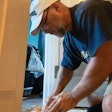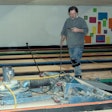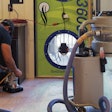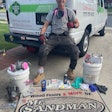In the old days, wood flooring contractors often wore bandannas rather than respirators to provide "filtered air." While this may have provided the Lone Ranger look, it didn't do much to protect their lungs. Your body has natural defenses to protect itself from contaminated air—your nose hairs help prevent large particles from going in your lungs, and when you cough, that may be a reaction to something in your body that shouldn't be there. But on a wood flooring job site, which can be full of dust and vapors, your body needs more help.
Fortunately, today's generation of wood flooring contractors are more concerned about protecting their own health, and it is commonplace to see them wearing respirators on the job. But, there is still a long way to go to overcome some common misconceptions about respiratory protection.
Dealing with Dust
One common mistake I see is contractors wearing dust masks instead of a National Institute for Occupational Safety and Health (NIOSH)-approved particulate respirator. NIOSHapproved particulate respirators provide a high level of filtration and, when properly used, greatly reduce the amount of dust or particles in the air drawn through the respirator. Approved particulate respirators will have "NIOSH" and the filter classification printed on them.
There are nine classes of NIOSHapproved particulate respirators. These include three series of filters: N, R and P, and three levels of filter efficiency: 95, 99 and 99.97 percent. Of these, Nseries filters, which are used for solid or liquid particles that do not contain oil (like wood dust), are the ones most commonly used on the wood flooring job site when installing or sanding. Ror P-series filters must be used if oil aerosols are present. Filter efficiency indicates how efficiently the filters remove very small, invisible airborne particles when tested per the NIOSH criteria. For example, an N95 respirator filters at least 95 percent of those particles. The higher the number, the higher the filter efficiency.
Safe Finishing
For finishing, contractors need to wear a respirator designed to protect against gases and vapors (you'll often hear people refer to "fumes" on the job site, but fumes are actually created by molten metals during things like welding and smelting and are particles). Gases and vapors are invisible contaminants mixed in the air, like solvent vapor evaporating off of a finish.
Most contractors think that some finishes are "safe," so they don't wear respirators. But the fact is, most finish manufacturers recommend you use an appropriate NIOSH-approved respirator; read the MSDS to find out which one is recommended.
For protection while finishing, you may need one of the half-face or full-face respirators with the appropriate activated charcoal cartridges (for some finishes, such as conversion varnishes, flooring contractors prefer full facepiece respirators). As soon as you open the sealed package that the charcoal cartridges come in, that cartridge is working. If you leave it hanging in the back of your van or sitting on the job site, the cartridge is being used up. So when you aren't using your respirator, you should put the cartridges into a clean, resealable bag or container. You should also follow the manufacturer's recommendations to clean your respirator and contact the manufacturer for assistance on proper respirator selection if needed.
A Good Fit
No matter which type of respirator you use, effectiveness will be reduced if it doesn't fit properly. Facial hair, for example, usually gets in the way of a good fit. If a mustache or goatee doesn't interfere with the seal of the respirator, it may be acceptable. If it does interfere, people will try using all sorts of things to improve the seal, like Vaseline or lotion, but that practice is not allowed under OSHA regulations.
When wearing a respirator, be sure to follow the manufacturer's instructions for fitting and use. For disposable dust respirators, it's important that you use both hands to form the little metal band so it fits snugly and evenly around the bridge of your nose. Also follow the instructions for a user seal check each time you put the respirator on to check the fit and make sure you are getting a good seal. All respirators must also be properly fit-tested to determine whether the respirator fits you appropriately. Carefully follow all of the user instructions to help you achieve the maximum reduction in exposure while wearing the respirator.
Change-Out
When using a disposable particulate respirator, you should change it out when it becomes damaged, soiled or you can feel that it takes more effort to breathe in and out. R- and P-series respirators have additional requirements for how long they can be used if oil is present. For cartridge respirators, the old recommendation was that you change the cartridges when you could smell or taste the vapor or gas. But since some people are more sensitive than others—a smoker, for example, may not smell something as quickly as a non-smoker— the current legal requirement is to have a set schedule to change out the cartridges based on their typical use.
Comfort
Comfort is an important feature in selecting a respirator and keeping it on your face while working. There are disposable dust respirators available now that have an exhalation valve, so the hot air you breathe out exits through the valve. That minimizes the hot, steamy air against your face and can help prevent steaming up glasses or other eye protection.
It's the Law
The Occupational Safety & Health Administration (OSHA) regulates workplace safety and has certain provisions just on proper respirator use. OSHA requires that employers have a written respiratory protection program in place and also perform training, fit-testing and medical evaluations before respirators are used by workers. Failure to comply with these requirements can result in citations and fines being issued to the contractor. There is one exception to a written program for use involving disposable particulate respirators under certain voluntary use situations (i.e. no particulate hazard is present in the air).
Most importantly, you need to make sure you and your workers have clean air to breathe. Your health depends on it.


































